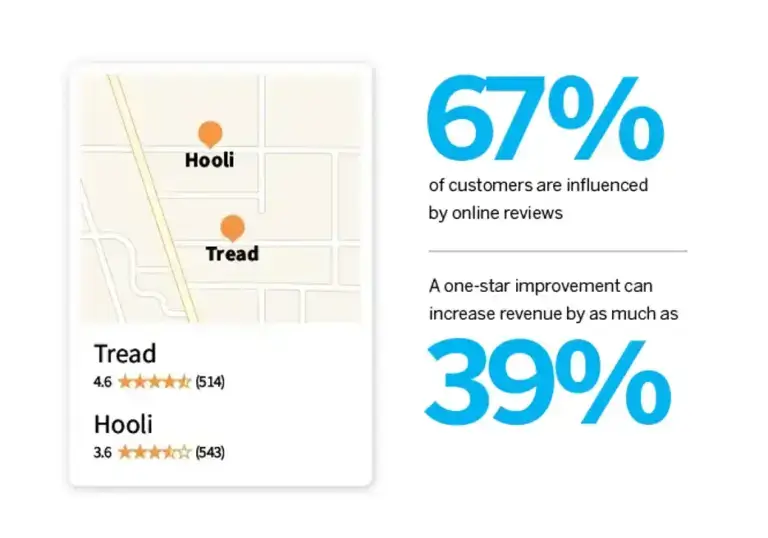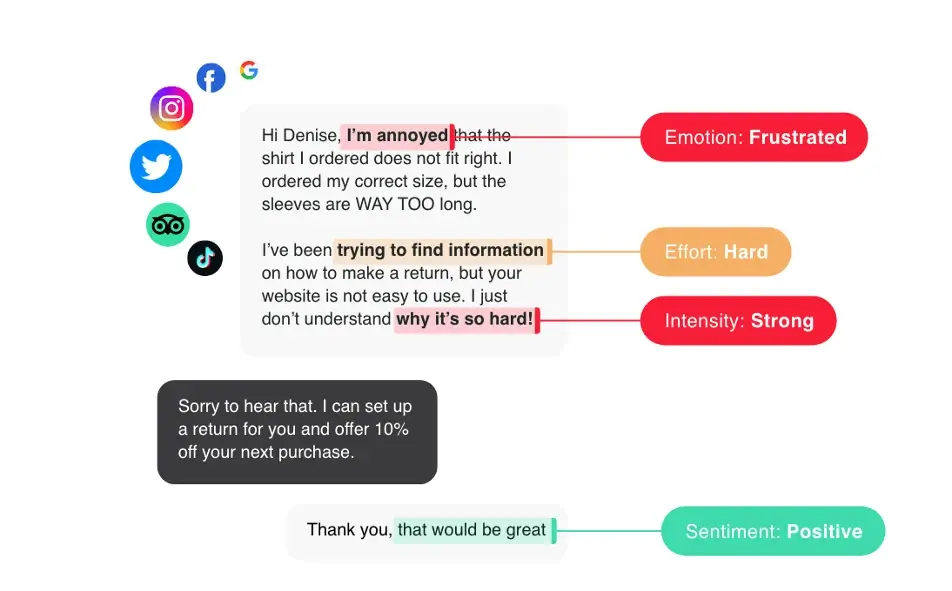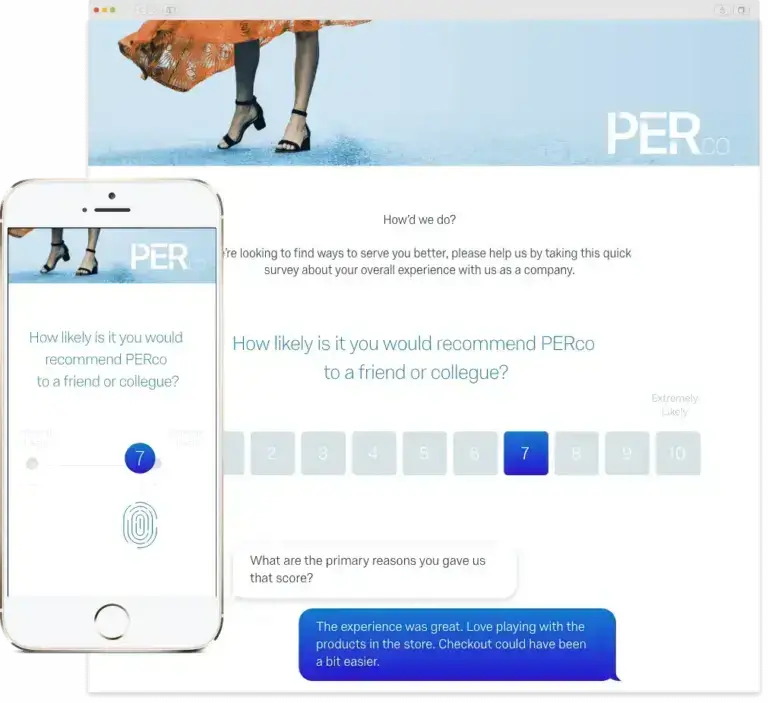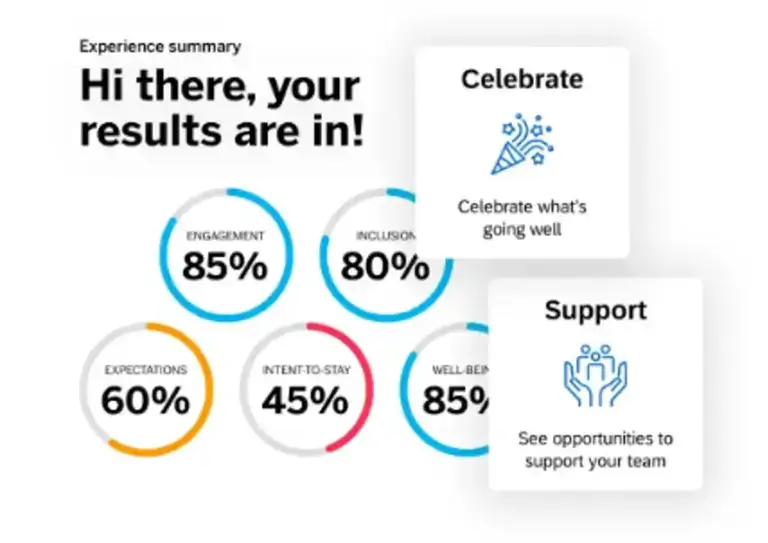Author: Adam Bunker
Subject Matter Expert: Elizabeth ErkenBrack
What are consumer insights?
Consumer insights are data points that show the behaviors, wants and needs, and demographic makeup of your target audience. As such, consumer insights can be incredibly broad – like learning that a certain kind of person shops for a certain kind of product – or very specific – like people in X zip code don’t tend to travel to the next one to shop.
Consumer insights shine a light on the whys behind buying, and help businesses understand what they need to do to better capture people’s attention, or drive them to make purchases.
Insights you gather will usually derive from a mix of market research, customer feedback and data science – this can be direct and indirect, solicited and unsolicited, and quantitative as well as qualitative.

Together, this customer information paints a picture of behavioral trends that shape metrics and strategies like finding your target demographic, driving customer churn, boosting customer retention, and discovering the drivers of customer loyalty.
Collecting and analyzing customer data will leave you with insights that let you understand where experience gaps and pain points lie, and that arm you with the knowledge you need to take proactive steps to make your products land with greater impact.
This kind of consumer research unearths actionable insights that businesses find useful answers to a variety of key questions like:
- Who is your target market?
- Are your products engaging to those customers?
- How can you boost your customer base?
- How can you drive down customer churn?
Free eBook: Moving your CX metrics forward
Consumer insights vs customer experience insights
If consumer insights is a broad term for the information you glean on shopper preferences and behaviors, then customer experience insights are more specific observations around the interactions your customers have with you throughout their journeys.
In other words, that’s insights on everything from the process of learning about you online, to how effective your customer support is.
Think of it like this: if someone has collected a bunch of ‘consumer insights’, they’re usually talking about insights they’ve gathered about the age or location of their customers, their buying preferences, and their behaviors. But ‘customer experience insights’ lets us know that we’re focusing on those all-important interactions and touchpoints.
Why are consumer insights important?
When you collect data and turn it into actionable insights, you’re learning what it’s like to be one of your (potential) customers – and you’re understanding what actions you need to take to make things better for them.
By analyzing this data and discovering deep insights, you’ll be able to:
- Learn what your target audience expects from you
- Make positive changes to your products
- Improve the buying experience
- Deliver world-class customer support
- Enhance your marketing campaigns
- Maximize customer lifetime value
That’s a more vital practice now than ever because customers expect much more from the brands they choose to do business with. In fact, today’s customers expect brands to understand them – and what drives them.

HubSpot, for example, recently found that some 66% of customers expect that the brands they do business with understand their needs – and those that do are 60% more profitable.
In our own XM Institute research for the 2023 Qualtrics Global Consumer Trends Report, we found that 63% of consumers think companies need to do a better job of listening to, and acting on, their feedback.
Not to get too meta, but these statistics are consumer insights in and of themselves – any information that helps you understand what motivates consumer behavior, and what to do a out it, is an insight.
Types of consumer insights
There are a bunch of different ways to categorize consumer insights, and each one should help determine actions and next steps. For example, psychographic insights may inform your messaging or marketing efforts, while customer journey insights can help shape improvements to your customer experience. The goal here is to match insights to appropriate solutions.
Here are the different types of consumer insights you should look to capture:
Demographic insights
Demographic consumer insights are facts about things like customer age, gender, income level, education, and location. These are helpful for segmentation, as well as for being more specific with the way you target different groups.
Psychographic insights
‘Psychographic’ means understanding their qualitative, characteristic traits. In the consumer insight space, that means details on personality, attitudes, interests, values, and lifestyles. These insights are useful for understanding customer motivations.
Behavioral insights
This is qualitative data that reveals how customers interact with your brand. That means exploring how they peruse options, make a purchase, use products, and respond to marketing. This kind of data reveals patterns that can be used to make tweaks to the overall buying experience.
Feedback insights
These insights are the result of direct input that you’ll collect through surveys, interviews, reviews, and conversations. Feedback-based consumer insights are a goldmine as they usually provide details about customer needs and opinions, right from the people that matter most.
Customer journey insights
The journey describes the steps customers take during their entire relationship with your brand. That obviously includes making a purchase, but it also includes the pre-and post-sale parts of the journey – including customer support. Journey-based insights are great for highlighting pain points that need to be fixed.
Motivational insights
What motivates customers to make the purchases they make? That’s a key question to answer, since it can inform everything from your marketing efforts to your products themselves. Motivational insights explore the drivers behind why customers buy certain products or brands.
Occasion-based insights
These insights represent situations or times when customers use products or make purchases. That might be an annual event like Christmas, or it might just be a pattern in which a customer treats themselves to something at a specific time of the month or year. Occasion-based consumer insights help you plan your targeting by moments.
Price sensitivity insights
These insights will help you identify which customers (or customer types within certain segments) are willing to pay more or less for specific items. This is really useful product information as it helps inform your pricing strategy.
Macro trends insights
When we talk about consumer behavior as a whole – across markets and industries – we’re talking about broader shifts in demographics, attitudes, and behaviors. That means exploring how customer behavior and tendencies change in general during events like a recession, during a global event like COVID-19, or just in line with wider changes in economies, technology, or society.
How do you find consumer insights?
Great consumer insights can come from a wide range of sources, but it’s worth focusing on data – and thus insights – that are relevant to your business and its goals. In general, strong consumer insights all share one thing in common: inherent meaning and value that can directly drive decision-making.
Here are a few ways to glean top-tier consumer insights:
Customer interviews and focus groups
With the right incentives, you can host in-depth conversations with your existing customers to better uncover their needs, pain points, motivations, and experiences. Likewise, you can bring together current or prospective customers to discuss topics related to your products as part of wider focus groups.
Surveys and feedback forms
You can use online surveys to gather feedback from a larger sample size of customers. The results from these – like CSAT, NPS, or more qualitative data – can provide information that can help identify priorities in terms of what needs fixing along the customer journey. It also helps to include short feedback forms wherever possible to capture input about specific touchpoints.
User testing
Observing how customers interact with your product can help pinpoint usability issues, as well as capture extra information about their opinions, likelihood to purchase, and what drives their product needs.

Contact center analytics
Using contact center analytics tools, you’ll be able to analyze support interactions across all touchpoints and find common questions, complaints, or requests. The scale of customer service interactions means it’s necessary to lean on technology here to bring everything together and find trends and insights that manual sampling wouldn’t be able to.
Social listening
Likewise, AI-powered tools that use natural language processing can monitor interactions on every social media channel, understand what people are saying, and turn those conversations into powerful consumer insights.
Web analytics
If you can track web analytics, you can glean and leverage customer insights around data like most visited pages, conversion funnels, and exit pages. Tools like session replay and heatmaps, meanwhile, can help you uncover customer insights around the success of your website’s UI and UX.
In-store observations
If your business has a physical presence, you’ll be able to watch shopper interactions, movements, questions, and body language. How they move around your store is a customer insight, for instance. Are they drawn to certain displays more than others? Or do they struggle to find something?
Customer journey maps
Outlining the key steps customers go through is a brilliantly powerful way to reveal potential pain points along the customer journey. Consumer insights based on the journeys they take can help you make proactive changes to streamline the route to purchase or customer support. Journey mapping is a great exercise to start with.
Segmentation analysis
Capturing information about your customers that can help you group them into audience segments. With this information, you can compare customer insights like demographics, psychographics and behavior.
Ultimately, the most effective approach here is one that combines quantitative data gathering with qualitative observations and conversations – often using AI-assisted tools – to gain a full, holistic understanding of your customers’ thinking and behavior. The key, as always, is turning insights into actionable opportunities to improve the customer experience.
How do consumer insights and market research intersect?
In short: market research is a supplementary process for any good consumer insights program.
Market research tends to mean gathering information about how consumers behave in general within a given sector or industry. Consumer research and insights, on the other hand, are usually concerned with the behavior and experiences customers have with your specific brand.

An example here might be that while market research shows consumer trends when it comes to buying sneakers, a specific sneaker brand can also drill down and collect more specific customer insight from its own customer base.
So, while market research deals in more generalist terms, it’s a process that goes hand-in-hand with more bespoke customer insights – the two can work together to help you build a more robust image of customer needs, wants, preferences, and purchasing decisions.
What makes for a strong consumer insight?
A strong consumer insight is one that serves as a strategic platform for change. It’ll be one that helps guide your business decisions and actions by letting you know what truly drives, frustrates or motivates your customers.
Powerful insights shine fresh light on consumer behavior patterns because they share a few common characteristics:
- Specific – focusing on a clear behavior, need or trend
- Actionable – informs a direct response
- Surprising – can help you disrupt the status quo
- Relevant – to your brand and product portfolio
- Timely – relates to current market conditions
Best practice: How to gather consumer insights that matter
Customer insights can come from a huge range of places, but pulling useful information from the multitude of data sources and voices can feel like finding a needle in a haystack without the right processes (and tools) in place.
Here’s how to sort the signal from the noise:
1. Listen to everything, everywhere, all at once
The first step in gathering customer insights is to ensure that you’re able to capture everything customers are saying about you, no matter where they choose to say it. Not all feedback will come directly to you, so it’s important to use tools that can marry solicited, direct feedback with unsolicited and indirect opinions from around the web – and generate consumer insights that unify everything.
This kind of data is priceless, but it’s impossible to gather manually. Instead, you’ll need a customer experience management tool that can understand sentiment, effort, and intent across social media, emails, phone calls, third-party review sites, live chat, and SMS – and automatically group trending concerns into insights.

2. Ask for regular feedback
Direct, solicited feedback is a fantastic way to gain a deeper understanding of how customers feel about their interactions with you. Not everyone will be willing to provide detailed answers to survey questions, but any written feedback you do gather will contain a wealth of useful experience insights alongside acting as useful market research opportunities.
There are lots of places and times in the customer journey where you can ask for feedback. Post-purchase surveys, app or website feedback boxes, Net Promoter Score (NPS), Customer Satisfaction (CSAT), and Customer Effort Score (CES) surveys should all be regularly posed and incentivized if you want to see how micro and macro trends in customer data change over time.
3. Avoid feedback fatigue
Asking for direct feedback as regularly as possible is really important, but you should also do what you can to avoid building feedback fatigue in your audience. Being asked too often to fill out surveys or score interactions is a surefire way to turn people off, but there are couple of key ways you can ensure that you’re toeing the line:
Personalize
Customers are more willing to answer surveys that have been personalized to them, and personalization can be done in a number of ways. You’ll want to be sure that you’re asking questions that are relevant to their buying habits, for one thing, but also think about the platforms you’re using: are you targeting the right people on the right channel? Maybe your audience uses one social platform more than another, for instance?
Strategize
If you were a waiter in a restaurant, you probably wouldn’t ask customers how their meal was before they’ve taken a single bite, or after they’ve cleared their plate. There’s a perfect time to ask for feedback, and there’s a natural cadence that works, too. So think about when (and how often) is best for your audience. For B2B audiences, best practice is to send customer surveys quarterly. For B2C, think about how often customers interact with you and double it.

4. Make customer service a human science
Don’t let customer service interactions sit untapped and underutilized. Your contact center is an incredible repository for customer insights – one that can be unlocked with an intelligent customer data platform capable of understanding the meaning and sentiment behind every interaction.
The volume of customer support queries most companies receive – across various mediums – makes it impossible to manually draw out and collate any deep insights. But a contact center solution that can understand customer behavior, automatically sift through calls and written complaints in real-time, and catalog customer experiences, will provide you with a real competitive advantage.

The goal is to bring all these disparate and innate human interactions into a single source of truth – one that can then proactively deliver real consumer insight.
How to use consumer and customer insights
The single best thing you can do with customer insights is to put them to work.
If you have a customer data platform sieving for insight gold, you’ll want to ensure you have processes in place to use them. And that means making whatever changes those insights suggest with a good degree of agility.
It’s important to build a culture of action that transcends departments – one that puts customer experiences at the forefront of every business decision. The right customer management platform can help here, by turning raw data into useful consumer insights using experience management tools.
Understanding pain points – and designing, building, and deploying personalized customer experiences that fix them – is the most effective way to grow customer retention and boost customer lifetime value.
With Qualtrics® Customer Experience software, you’ll be able to bring omnichannel feedback together into one place, make sense of customer trends, and make proactive changes that drive real change.
Free eBook: Moving your CX metrics forward